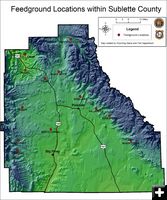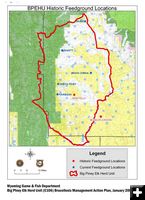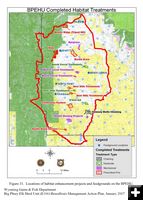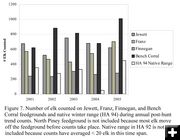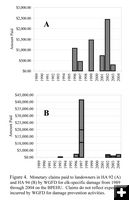WG&F plans for Piney elk herd
by Cat Urbigkit, Pinedale Online!
January 17, 2007
The Wyoming Game and Fish Department has finalized its plans for controlling brucellosis in the Piney elk herd in issuing its Piney Elk Brucellosis Management Action Plan. Although closing elk feedgrounds was one option considered, the plan recommends against such action. The plan changes the classification of the North Piney feedground to that of a “staging area/feedground.”
Piney elk BMAP released
Last week, the Wyoming Game and Fish Department presented the Brucellosis Management Action Plan for the Piney elk herd.
The Piney elk herd unit encompasses most of the elk habitat of the Wyoming Range north of LaBarge Creek and south of the Hoback Rim, containing the Franz, Jewett, Bench Corral, North Piney and Finnegan winter elk feedgrounds.
This BMAP was designed to identify what livestock producers and wildlife managers can do to reduce brucellosis transmission among wildlife and from wildlife to livestock.
Biologists worked closely with local livestock producers and federal agencies to develop the recommendations outlined in these plans.
Brucellosis is a bacterial-caused disease of the reproductive tract that is common in elk and bison in western Wyoming. Transmission from elk to cattle occurred in western Wyoming in 2003, leading to the state losing its coveted brucellosis-free status for its livestock herds. Wyoming regained its disease-free status last fall.
Elk and bison in the Yellowstone region serve as a reservoir for the disease. A cooperative state and federal program aimed at eradicating brucellosis has been in place for more than 70 years.
Eight options are presented in the BMAP to minimize brucellosis transmission risk. The pros and cons of each of these options are presented, as well as the management options that WG&F will pursue.
The Brucellosis Coordination Team outlined the BMAP process as a critical step for preventing brucellosis transmission from elk to cattle and regaining the state's brucellosis free status. Brucellosis transmitted to cattle herds from elk caused Wyoming to lose its brucellosis free status in 2004. The state’s brucellosis-free status was officially restored on Sept. 15, 2006.
Staging area created
In finalizing the Piney Elk Brucellosis Management Action Plan, the Wyoming Game and Fish Department created the first “staging area/feedground” for wildlife in the state.
The plan changes the classification of the North Piney elk feedground to that of a “staging area/feedground.”
The reason for the change is that for the last 11 years, elk leave the North Piney feedground, usually by mid-January, and head to lower country and feeding on the Bench Corral elk feedground. This year, elk fled North Piney at a run about 10 days ago, according to Scott Werbelow of WG&F.
Why? Because WG&F taught them the route, as Big Piney rancher Jim Mickelson pointed out to the agency at a meeting last week. Mickelson noted that he fed the elk all winter long for 13 winters, but once WG&F baited the animals in the winter of 1995, the elk have left every year since.
The trouble began when WG&F, planning on closing the North Piney feedground on the edge of the Bridger-Teton National Forest, baited elk down onto the lower elevation Bench Corral in 1996, during the federal government shutdown, contrary to the Bureau of Land Management's assertion that an environmental assessment needed to occur prior to the action. WG&F dropped the plan to close the feedground, but the first year of baiting was enough for the elk, which had learned to move to the lower elevation feedground, and that movement has continued every year since the one year of baiting.
The new Piney BMAP noted: “Because North Piney feedground typically ‘collects’ elk and likely prevents damage to producers along North Piney Creek prior to their annual migration to Bench Corral feedground, WG&D has proposed to reclassify and manage North Piney feedground as a ‘staging area/feedground’ but will not consider the North Piney staging area/feedground for relocation at this time.”
The plan states that elk that leave North Piney will not be hazed back but allowed to migrate to Bench Corral feedground.
“Establishing a cut-off date for feeding and/or encouraging elk to leave North Piney with various methods (e.g., baiting to Bench Corral, reducing amount of hay fed per day, hazing) may be pursued following future re-evaluation of conditions at North Piney,” according to the BMAP.
After listening to WG&F’s Eric Maichak’s presentation about the Piney elk BMAP, Lloyd Dorsey of the Greater Yellowstone Coalition offered praise. Dorsey has followed the creation of BMAPs for several other western Wyoming elk herd units and called the Piney plan more comprehensive than the others.
“This effort is going to prove to be a resource,”’ Dorsey said, after reviewing the historic information and research included in the document.
The Piney elk herd is now about 1,100 head over objective. With about 3,500 head currently, the objective set by the agency is 2,400.
_________________________________
Maps and charts from the Big Piney Elk Herd Unit (E106) Brucellosis Management Action Plan report, Wyoming Game & Fish Department, January 11, 2007
|
